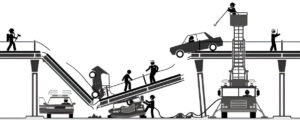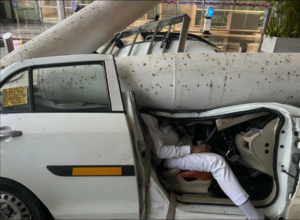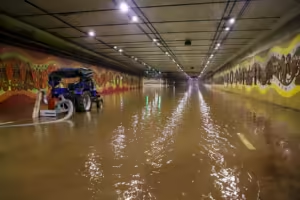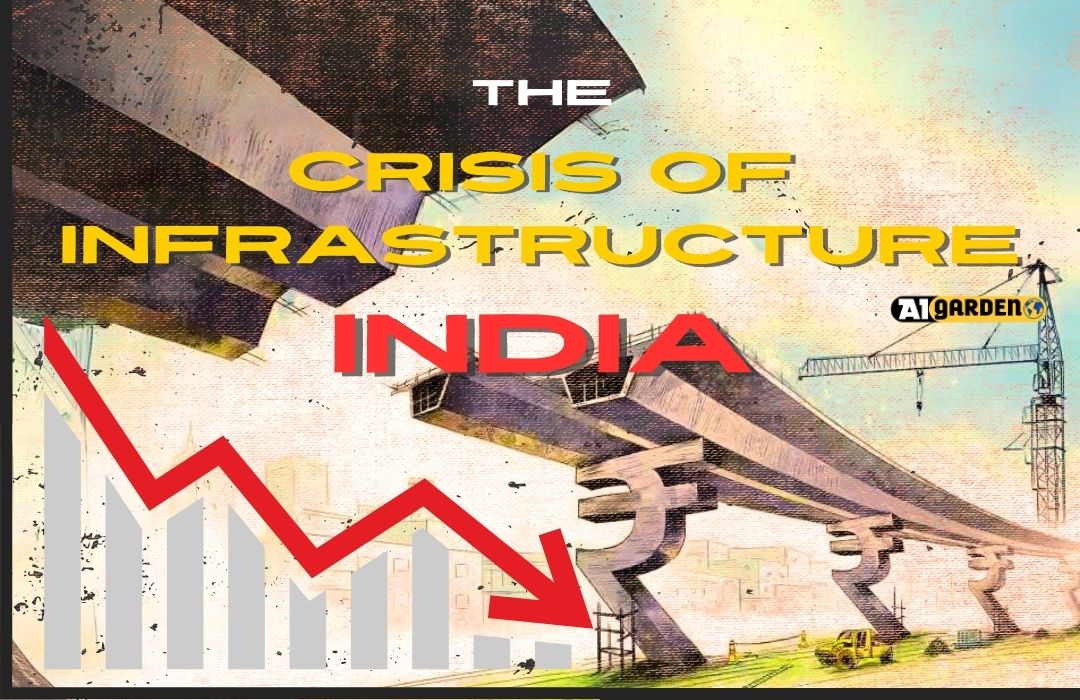A diligent 45-year-old man named Ramesh Kumar went to the Delhi Airport on June 28, 2024, to drop off a customer. To save money for his older daughter’s wedding, he was putting in extra hours at work. Sadly, he was killed when the roof of Terminal 1 at Delhi Airport collapsed on his car just after he dropped off his customer. This episode is part of a troubling pattern in India; it is not an isolated occurrence.
With the recent bridge and infrastructure disasters exposing serious systemic flaws, The Crisis of Infrastructure has reached frightening proportions. This blog post explores the origins, effects, and possible fixes for this continuous problem.
We will look at the history of The Crisis of Infrastructure, the most recent collapse instances, the underlying causes, the effects on society, the government’s remedies, and possible ways to stop catastrophes in the future.
An Historical View:
The swift urbanization and economic expansion of India have demanded a large-scale infrastructure construction. But a large portion of the current infrastructure is outdated and in serious need of repair. These problems have been made worse by past neglect and underinvestment.
Recent Incidents:
BIG BREAKING 🚨
Singapore international media covered the Delhi airport roof collapse.
Yet another international shame for India because of ‘Non-biological’. pic.twitter.com/BsVP7hijAW
— Rohini Anand (@mrs_roh08) July 5, 2024
- The roof of the recently opened airport in Jabalpur collapsed on June 27, 2024.
- Two individuals lost their lives when a 250,000-liter water tank in Mathura fell on July 1.
- Within 15 days, seven bridges in Bihar collapsed, shattering all previous records for infrastructure failure.
These occurrences are indicative of a larger public infrastructure disaster in India.
The Crisis of Infrastructure: Reasons for Bridge Failures

Outdated Infrastructure: A large number of India’s infrastructure, including bridges, was constructed decades ago and is now beyond its projected lifespan. These buildings are prone to failure in the absence of sufficient maintenance and modifications.
Inadequate Maintenance: Many structures are at risk of collapsing due to inadequate and inconsistent maintenance schedules and a lack of money for repairs.
Mismanagement and Corruption: Mismanagement at all levels, from building and upkeep to purchasing, results in inferior materials and weakened safety regulations. This issue is made worse by the usage of L1 contracts, which award contracts to the lowest bidder regardless of quality. For example, the collapse of the Morbi Bridge in Gujarat was ascribed to a low-bidder company that had no prior experience in the field getting the contract.
Natural Elements: Natural catastrophes including earthquakes, floods, and intense monsoons are common in India. These environmental elements can have a serious effect on badly maintained structures.
Flaws in Design and Construction: Neglecting to follow engineering best practices, using inferior materials, and making design mistakes can result in disastrous disasters. One prominent example is the Pragati Maidan Tunnel project in Delhi, which had architectural problems and was rendered useless in less than two years.
The Crisis of Infrastructure: Repercussions of Bridge Collapses
Cost to Humans: The loss of human life is the most sad outcome. The untimely loss of lives resulting from infrastructural failure is not limited to the Delhi Airport roof collapse. Eight,500 persons have lost their lives as a result of public infrastructure failure between 2018 and 2022.
Cost Effects: The financial fallout is substantial, resulting in lower economic output and productivity due to direct reconstruction expenditures as well as indirect costs like trade delays and everyday commutes.
Public Confidence: The public’s trust in civic authority and the government is undermined by frequent infrastructure breakdowns. People start to doubt public infrastructure’s dependability and safety.
The Crisis of Infrastructure: Case Studies
Recent Examples of Recent Bridge Collapses in India:-
Delhi Airport Roof Collapse:

A 45-year-old taxi driver named Ramesh Kumar lost his life when the roof of Terminal 1 at Delhi Airport collapsed on June 28, 2024. He was working extra hours to save money for his elder daughter’s wedding. This happened not long after he dropped off a client at the airport. The fall brought to light serious flaws in the upkeep and security requirements of the airport’s infrastructure.
Numerous media outlets and the general public expressed their displeasure over the tragedy, which prompted urgent calls for accountability and upgrades to infrastructure safety. This tragedy serves as a sobering reminder of the larger issues plaguing India’s public infrastructure, where mismanagement, low maintenance, and insufficient safety audits routinely result in catastrophic failures.
Morbi Bridge Collapse:
The historic suspension bridge over the Machchu River collapsed on October 30, 2022, in Gujarat, India, leaving 140 people dead. The bridge had just undergone renovations and had been reopened to the public without a clearance certificate. The renovation contract had been given to Oreva, a company that specialized in making lighting and clocks but had no significant experience building or repairing bridges.
Nine persons were detained after the incident, including low-level workers like ticket clerks and security guards, but no government authorities or high-ranking officials accepted accountability.
The Pragati Maidan Tunnel:

Prime Minister Modi opened the Rs. 777 crore Pragati Maidan Tunnel in June 2022, but it soon came to represent a failure of infrastructure. Although the tunnel’s quick construction and cutting-edge features won accolades at first, after just two years it began to have serious operational problems. Due to significant water blockages caused by inadequate drainage systems and poor waterproofing, particularly during the monsoon season, it became useless due to technical and design problems. Experts in urban planning noted that the project’s soil and rock conditions were inadequate.
Kolkata Vivekananda Flyover Collapse: On March 31, 2016, the Kolkata Vivekananda Flyover collapsed in the vicinity of the Girish Park metro station, leaving 26 persons tragically dead. A 150-meter piece of the still-under-construction flyover unexpectedly collapsed during a crowded lunch hour, crushing cars and pedestrians below. The construction company IVRCL, which won the contract by putting in the lowest bid—a procedure known as the L1 method—was held accountable for the collapse. Subpar construction was the result of the company’s repeated cost-cutting measures, according to investigations. At first, IVRCL’s director of operations referred to the tragedy as a “act of God,”
Analysis: Every case study exposes recurring issues like poor design, subpar materials used, corruption, and improper maintenance. Particular situations, such as natural disasters, also matter.
The Crisis of Infrastructure: Reaction of Government and Policy

Present-day Procedures:
Current rules are mostly based on the L1 contract technique, which puts money before quality. This strategy has consistently shown to be insufficient.
Recent Initiatives: In 2021, the Finance Ministry unveiled rules for a quality-cum-cost-based selection system; nevertheless, it is not a replacement for the L1 system and is only used in certain situations.
Criticism: These programs are not broad enough, even though they represent positive moves in the right direction. Because of the L1 method’s persistent use, many projects are still chosen solely on the basis of cost, with little consideration given to quality or safety.
Also read about Hathras Satsang Stampede news
The Crisis of Infrastructure: Remedies and Suggestions
Better Maintenance: Timely, comprehensive inspections and maintenance plans are essential. Prioritizing funding for upkeep should go hand in hand with new building initiatives.
Open-Source Sourcing:
Many problems can be avoided by switching from the L1 system to a multi-criteria selection framework that assesses the contractor’s experience, quality, and safety records.
Innovations in Technology:
Infrastructure can be made more resilient and safe by utilizing contemporary technologies like drones for inspections, automated monitoring systems, and sophisticated materials.
Collaborative Ventures:
Partnerships between the public and private sectors can increase efficiency and competence. These collaborations must to be set up to guarantee quality and accountability.
Community Involvement: Including neighborhood groups in infrastructure upkeep and monitoring can guarantee prompt reporting of any problems and extra oversight.
The Crisis of Infrastructure: Final Thoughts
Recap:
Recent bridge disasters have brought attention to India’s infrastructure problems, which is a complicated problem with a foundation in corruption, poor upkeep, and insufficient regulations. The costs, both financial and human, are enormous, and public confidence is declining.
A Call to Action:
We urge readers to support improved infrastructure practices and policies. Change can be sparked by public pressure and awareness.
Prospects for the Future:
India has the potential to enhance its infrastructure and avert further tragedies by implementing appropriate reforms and prioritizing quality and safety. There is a lot of room for development, but both the public and the government must be willing to take initiative and be committed.
